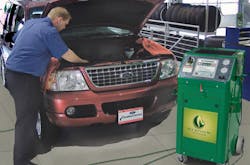Nitrogen inflation is a relatively new service for the tire industry. However, it is rapidly moving from “trend” to “commonplace.”
The figures don’t lie. Nearly 33% of the tire dealers responding to our 2008 Nitrogen Inflation Service Survey said they offer nitrogen service, up from 21% in 2007. Another 10.1% said that although they do not offer it, they plan to add it in the future; in 2007, 8% planned to add the service.
As part of its “2009 RPM Awards,” Maxim referenced nitrogen-filled tires in its report on the Nissan GT-R. Mainstream may be just around the corner.
Cost of doing business
Although Costco Wholesale Corp.’s 400 stores offer nitrogen inflation as a value-added service, the vast majority of dealers (89.2%) reported they charge car owners for it. Of the dealers who charge to inflate tires with nitrogen, 80% charge at least $5 a tire, while 20% ask anywhere from $1 to $4 per tire.
The range for light truck tires is broader:
Fee for filling a light truck tire w/nitrogen
$1-$4: 13.9% $5-$6: 43.7%
$7-$8: 22.5% $9-$10: 13.9%.
The remaining 6% of the dealers who offer nitrogen inflation charge more than $10 per tire for the service.
Two hot trends
Nitrogen inflation equipment has been evolving to meet the needs of tire dealers. Here are the latest trends, according to equipment suppliers.
1. Portability. Suppliers agree that portable units are becoming more popular.
Kelvin Butz, RTI Technologies Inc.’s vice president of marketing, says the thought process among many dealers has been to set up a reservoir and then pipe the nitrogen out to several outlets.
“We’re finding the swing is away from that and toward portable machines. Versatility in the shop is very important.”
The more flexible the shop, the more cars you can process, he says. “The ability to maneuver (these machines) in tight corners is extremely important.”
“I think you have two options,” says NitroFill Inc. President Jay Lighter. “First, you can completely embrace nitrogen and buy a stationary unit. If you believe in nitrogen, why wouldn’t you want it available at every bay? Then you can run one line to your tire machine and multiple lines throughout your shop.
“However, it’s a tough to convince dealers who have been using air successfully that they need to invest in that infrastructure. So the market is demanding a portable machine. People want to put their toe in a little bit first.”
2. Bundling. Instead of marketing nitrogen as a one-time sale, dealers should bundle nitrogen into an overall service package, according to nitrogen equipment suppliers.
Lighter cites his company’s NitroFill Auto Club program as an example. “When a consumer buys NitroFill, he or she receives unlimited use of roadside assistance for one year, prepaid through GE Capital.
“We send newsletters directly to customers and invite them back every 30 days. Our dealers also have the ability to go on-line and add print and clip coupons and other pieces... they can create their own service coupons, customer surveys, whatever they want. It becomes a tire inflation maintenance program.
“The real value to the customer is keeping those tires inflated, and the real value to the dealer is getting the customer to come in,” he continues. “You can’t sell anything if the customer doesn’t come in. Once you get traffic, you can point out those (worn) wiper blades. That’s what gives you the opportunity.”
Phil Giallombardo, director of sales for Branick Industries Inc., agrees. “Instead of just providing nitrogen and getting $20 for the service,” he says, combine it with tire protection, roadside service, etc., and you can charge more.
“The automobile dealers have perfected how to bundle services. If tire dealers can bundle nitrogen into a bigger program, they could provide a better value to the customer.”
Of course, customers must understand the benefits of nitrogen, says Ed Campea, regional manager for Champion, which is owned by Gardner Denver.
“Right now, nitrogen is voluntary; it has to be sold. People don’t come in and say they want nitrogen. You have to tell them the benefits and reasons and what they’re getting.
There will come a day when nobody will use compressed air; nitrogen will be a commodity. Dealers have an opportunity to make some money by selling it. But the customer has to understand what he’s getting for his money. That’s the biggest challenge.”
A significant number of dealers accepted the challenge years ago. According to the nitrogen inflation service survey, 4.4% of tire dealers have been offering it for more than five years. ■
New products:
Gardner Denver:
Gardner Denver is promoting its NA6-3P portable inflation generator, says Susie Wray, marketing manager for the company. The system offers 3.2 scfm of nitrogen output and an automatic purge system that allows operators to purge and inflate four tires simultaneously.
Features include a 30-gallon receiver, four inflation hoses, six auxiliary ports and a Prism membrane.
The NA6-3P is ideal for passenger and light truck facilities that need to be able to bring the nitrogen inflation directly to the vehicle, says Wray. "You can wheel it around. You don't have to worry about using any connections."
RTI Technologies Inc.:
RTI Technologies Inc.'s new portable nitrogen inflation system, the NitroPRO NTF-515, uses the company's NitroPRO Membrane Nitrogen Generation Technology, which contains no moving parts and includes four-stage filtration. The device includes a programmable, integrated controller and display to accommodate various pressure settings. "The NTF-515 will adapt to almost any operating condition," says RTI CEO and President Jeff Murphy.




